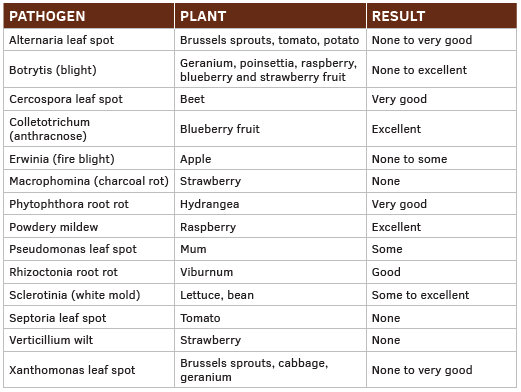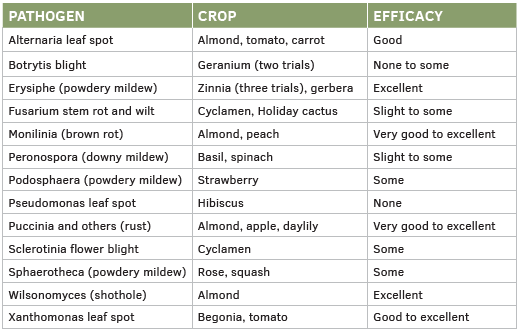New Biopesticides for Greenhouse Crops
When I started my career, about 40 years ago, biological control was known and studied but not in practice in many parts of agricultural production. Today we have come far with several new products launched annually. In most cases, these products are as well researched and understood as currently launched conventional fungicides.
In many cases, the companies launching the products also produce conventional fungicides but sometimes they focus primarily on biopesticides. In this article I have decided to focus on four of the newest biopesticides that have reached the greenhouse/ornamentals market. Each of the four products below are OMRI-listed. I have not placed them in any particular order.
STARGUS BIOFUNGICIDE
Marrone Bio Innovations
The active ingredient in Stargus Biofungicide is listed as a beneficial rhizobacterium that colonizes plant root hairs, leaves and other surfaces to prevent establishment of fungal and bacterial plant diseases. The active agent is Bacillus amyloliquefaciens strain F727* cells and spent fermentation media.
The label lists disease control for Botrytis species (gray mold), powdery and downy mildews, black spot on citrus, Phytophthora blight and late blight. It is also registered for some soil-borne pathogens including Fusarium, Phytophthora, Pythium, Rhizoctonia and Sclerotinia species as well as some others. Check Table 1 for a summary of efficacy trials that have been done on all crops (including experimental trials on ornamentals).
Stargus is currently registered on edible field crops including a long list of herbs and spices. As far as I can tell, it it not registered for ornamentals specifically. It has a four-hour REI and a signal word of CAUTION.
Best disease control is achieved when Stargus is applied preventatively in a regularly scheduled protective spray program. The manufacturer also suggests using it in rotation or tank mix program with other registered fungicides. The label allows for application flexibility with foliar, aerial, chemigation and soil applied methods.

In a couple of recent trials, Stargus was tested on two soil-borne root diseases on woody ornamental by Baysal-Gurel (Tennessee State University). The crops were viburnum with Rhizoctonia root rot and hydrangea with Phytophthora root rot. Stargus provided control in these two trials that was equivalent to RootShield Plus and nearly as good as the conventional root disease fungicides for Phytophthora (Empress, Segovis and Subdue Max) and Rhizoctonia (Empress and Mural). It is important to note that the application interval in these trials was weekly while the other products were applied on a three-week interval or much longer (RootShield Plus and Subdue Maxx).
ECOSWING BOTANICAL FUNGICIDE
Gowan
EcoSwing is an extract from Swinglea glutinosa in the FRAC P-05 group. It is preventative and curative and has some SAR capacity. EcoSwing should be applied at the first sign of infection and again on a seven- to 10-day interval. EcoSwing is safe on most plants and compatible with most fungicides and insecticides. Gowan does recommend using a small jar test and spraying a test plant when using any new product or product combination on your crop.
EcoSwing’s primary mode of action is to act as a contact desiccant and cell wall disruptor to the fungal hyphae. Preliminary research also suggests that EcoSwing may aid in triggering innate plant responses to help boost plant’s natural defense mechanisms against fungal pathogens. Trial works also shows efficacy on some foliar bacteria like Xanthomonas (see Table 2).

EcoSwing is labeled for indoor and outdoor, greenhouse food and nonfood crops, vegetable, fruits, herbs, tree nuts, ornamental flowers, trees, shrubs and plants, landscapes, parks, recreational areas, plants growing in containers, interiorscapes, home and garden. It is labeled for nearly all crop types including ornamentals.
BOTRYSTOP
BioWorks
BotryStop is a live spore preparation of a non-pathogenic saprophytic fungus, Ulocladium oudemansii strain U3. BotryStop aggressively occupies the same physical space and out-competes pathogens for the nutrients and space on the dead and senescing plant tissue; it is a true antagonist. With this mode of action, it is highly unlikely that resistance to BotryStop will develop.
BotryStop is an organic biofungicide for the control of pathogens such as Botrytis cinerea, Sclerotinia sclerotiorum and Monilinia spp. BotryStop provides protection to blossoms, fruit and plant tissues form these related fungal pathogens. The product has a four-hour REI. BioWorks has carefully researched this living biological control pageant for compatibility with a wide range or conventional and biopesticide products. This compatibility can be found on their website. Since it is a living fungus, care must be taken not to tank mix or rotate with something that can kill it. It is compatible with most wetting agents and biopesticides. Some of the fungicides that should not be mixed with BotryStop include: Heritage, CEASE, Daconil, Palladium, Chipco 26019, Dithane and RootShield PLUS.
BotryStop is sensitive to heat and special care must be taken to maintain its viability. Shelf life of the product is 12 months when refrigerated — ideally kept below 68° F. Do not freeze the product as it will damage the spores.

We have tested (as well as others) this product for efficacy against currently unlabeled diseases especially bacterial leaf spots like Pseudomonas and Xanthomonas (Table 3).
KALMOR
OHP Inc.
There are a number of copper products available for greenhouse growers. Some are even OMRI-listed including Kalmor from OHP. KALMOR is a dry flowable formulation with 46% copper hydroxide. REI for greenhouse uses ONLY is 24 hours with eye wash stations (refer to the container label for further information). For outdoor uses the REI is 48 hours.
Kalmor works at multiple sites. Absorbed copper disrupts the enzyme systems of the fungal and bacterial pathogens. Kalmor works both as a curative and a preventative fungicide. For best control, apply Kalmor when disease symptoms first begin.

Kalmor may be used on ornamental plants grown in commercial greenhouses and nurseries, and on conifers, vegetables, small fruits and nuts. It can be applied as a foliar spray or drench on ornamental plants at 0.5 to 2.0 pounds per 100 gallons. If Kalmor is applied in a spray solution having a pH of less than 6.5, phytotoxicity may occur. Do not tank mix with low pH products like Aliette or B-Nine. Extended periods of wet weather or very high humidity may result in copper burn. Kalmor has been safe in our trials and has shown high efficacy against many bacterial diseases (our current focus with this product).


 Video Library
Video Library 




















